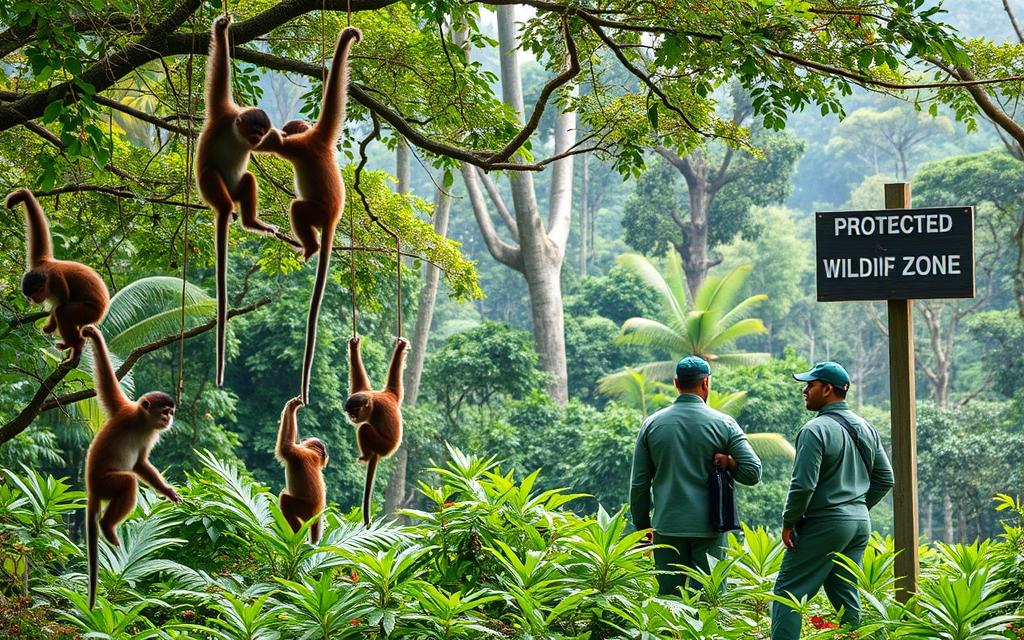
Protecting Wildlife: Sacred Monkey Forest Conservation Efforts Explained
Did you know the Sacred Monkey Forest Sanctuary in Ubud gets about 10,000 visitors every month? It’s home to around 1,000 monkeys. This place is more than a spot for tourists. It’s a key spot for protecting the Balinese long-tailed monkeys and helping with wildlife conservation in Bali.
It started in the 14th century. Now, it mixes caring for the environment with tourism. This fits well with the Tri Hita Karana idea. This idea means living in balance with people, nature, and the divine.
They’re working hard to stop rabies in monkeys. They want to make sure there are no monkey deaths or rabies cases in Bali by 2024 and 20281. This article will look at how the sanctuary protects these amazing animals and the environment. It will also see how tourism helps with this.
Key Takeaways
- The Sacred Monkey Forest Sanctuary is a vital hub for over 1,200 long-tailed macaque monkeys.
- The forest showcases three revered Hindu temples and is a center for spiritual practices.
- Efforts are focused on both wildlife protection and sustainable tourism to benefit the local economy.
- Monthly visitor numbers reach around 10,000, significantly boosting Ubud’s tourism sector.
- The forest follows strict guidelines to maintain the health and safety of both visitors and monkeys.
- Conservation programs aim to eliminate rabies threats by collaborating with organizations like World Animal Protection.
Introduction to the Sacred Monkey Forest
The Sacred Monkey Forest, known as Mandala Suci Wenara Wana, is a special place in Ubud Bali. It covers 12.5 hectares and is home to about 600 Balinese long-tailed monkeys. These monkeys live in groups and have complex social lives23.
More than 10,000 visitors come each month to see these amazing animals in their home2. It’s close to Ubud’s center and helps protect wildlife and supports the local economy through tourism4.
Walking through, you’ll see old temples and beautiful trees. There are over 100 types of plants around you2. Kids under three get in free, and adults pay a small fee that supports conservation3.
This place shows how nature and tourism can work together. It highlights the need for protecting wildlife in Ubud Bali.
Historical Significance of the Monkey Forest
The history of Monkey Forest goes back to the 14th century, even before Indonesia was a country5. It’s a key part of Balinese culture, seen as a sacred place where spirits live. Over 1,200 long-tailed macaques call it home, along with three important Hindu temples6.
Tourism started in the 1970s, making the Monkey Forest a big hit7. Now, more than 10,000 people visit every month to feel its history and see the wildlife5. Adults pay about Rp80,000 to enter, making it easy for many to experience this mix of nature and culture5.
Walking through, you see nature and religion living together, thanks to Balinese culture. Seeing the monkeys up close is like stepping into one of Bali’s most sacred places. It’s an experience full of wonder and respect for its old ways.
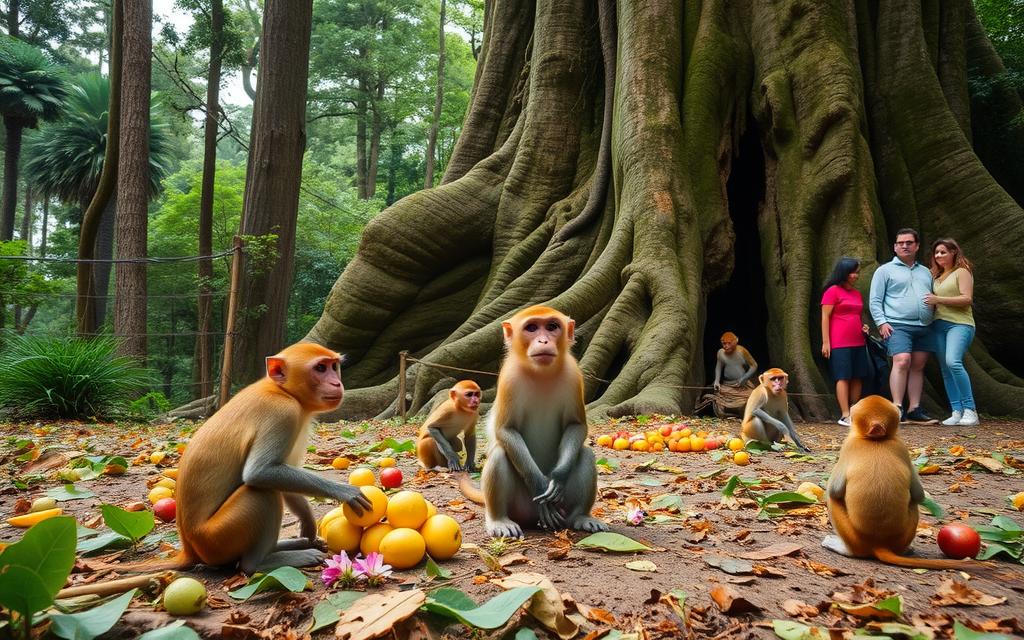
Understanding Balinese Long-Tailed Monkeys
At the Sacred Monkey Forest Sanctuary in Ubud, you’ll see the amazing Balinese long-tailed monkeys. These agile creatures are known for their playful ways. They show us how complex their social lives are. This makes your visit more interesting and shows why we need to protect them.
Physical Characteristics and Behavior
Balinese long-tailed monkeys, or macaques, stand out with their slender bodies and expressive faces. They live in groups and show many interesting behaviors. You might see them grooming each other, which helps keep their social bonds strong.
The Sanctuary spans 12 hectares and is home to over 700 of these playful monkeys. This gives you a great chance to see their fun interactions all day8.
Social Structure of the Monkeys
The social life of Balinese long-tailed monkeys is complex and often has a hierarchy. Studies show they have many kinds of interactions, from being assertive to caring for each other9. Dominance is key to keeping their groups in order.
Visitors can see these dynamics up close. You’ll notice how their place in the group affects their actions, like who they groom or feed. These social behaviors are crucial for their survival and happiness in the wild.
Experts are always studying these monkeys to learn more about them. By understanding their looks and social life, we see why we must protect their home and the culture linked to them98.
Role of Conservation in Ubud’s Economy
In Ubud, conservation is key to both wildlife tourism and the local economy. The Sacred Monkey Forest, covering about 12.5 hectares, draws tourists who want to see Balinese long-tailed monkeys up close10. This place boosts Ubud tourism and gives locals jobs, helping the economy.
Wildlife tourism helps protect nature and supports local businesses. The Ubud Monkey Forest has over 700 monkeys and 186 tree species. It attracts visitors worldwide, showing off its rich biodiversity11.
By linking conservation and economy, Ubud shows how taking care of the environment helps everyone. More travelers want real wildlife experiences. This helps the local community and the environment.
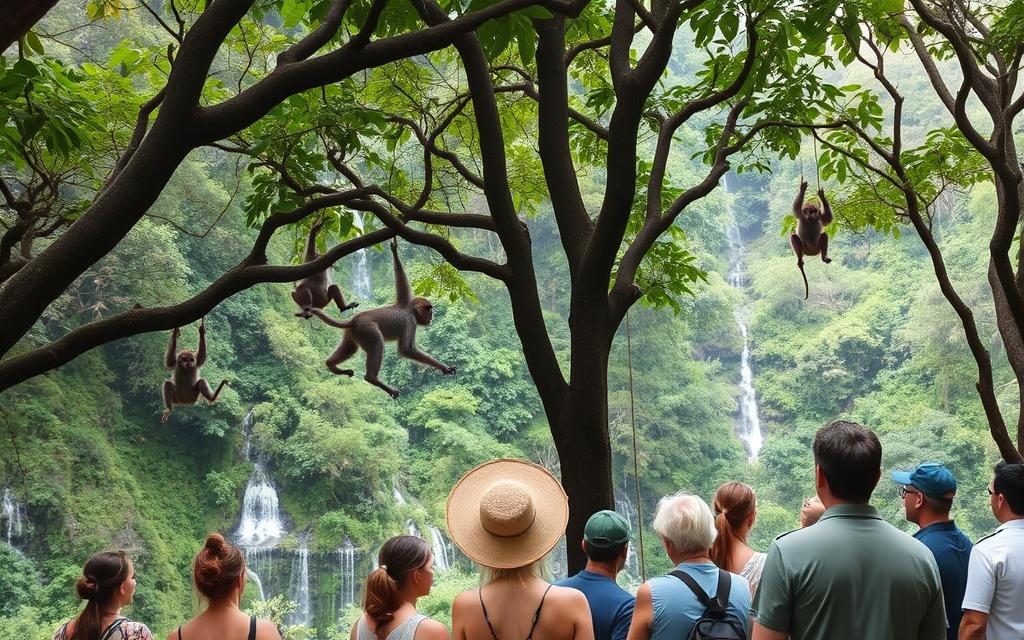
The mix of conservation and economy in Ubud creates a sustainable tourism model. It respects Ubud’s culture, making it a top choice for eco-friendly travelers.
This partnership proves wildlife tourism’s power. It boosts community pride and highlights Bali’s natural beauty1011.
Sacred Monkey Forest Conservation Efforts and Wildlife Protection
The Sacred Monkey Forest in Ubud is doing great thanks to conservation efforts. These efforts bring local communities together and help protect wildlife. A big part of this is through
community-based initiatives
. This means locals are involved and feel they own the wildlife they help protect.
Community-Based Conservation Initiatives
Getting the community involved is key to protecting wildlife. When people help out, they keep their natural world safe. The Monkey Forest is home to 1,260 monkeys and has 186 tree species. It’s a big job to keep it safe, and everyone must work together12.
Using local traditions and beliefs makes the community-based initiatives stronger. Visitors are taught not to stare at the monkeys. This helps keep the monkeys calm12.
Educational Programs about Wildlife Protection
Education is also a big part of the sanctuary’s work. Programs teach people about protecting nature and responsible tourism. The sanctuary faces dangers like car accidents and pollution, which are taught in these programs13.
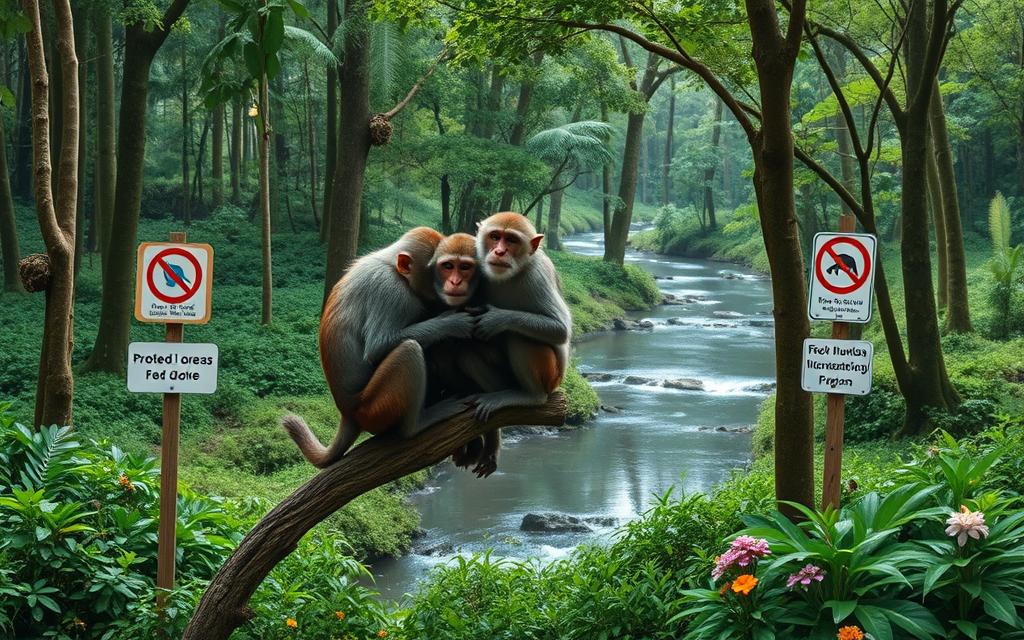
These educational efforts help fight against these dangers. Working together with local people and good management is key. It mixes old ways with cultural values for a better future13.
Environmental Sustainability Practices
At the Sacred Monkey Forest, they use environmental sustainability practices to protect nature and culture. They focus on reforestation, waste management, and eco-friendly tourism. This helps keep the forest healthy.
The forest is big, covering 12.5 hectares, and is home to 900 monkeys and 186 tree species14. It shows their strong commitment to biodiversity conservation.
Local wisdom is key to their efforts. They use the Tri Hita Karana philosophy. It balances people, the environment, and spirituality. This makes conservation efforts work well and respect local culture.
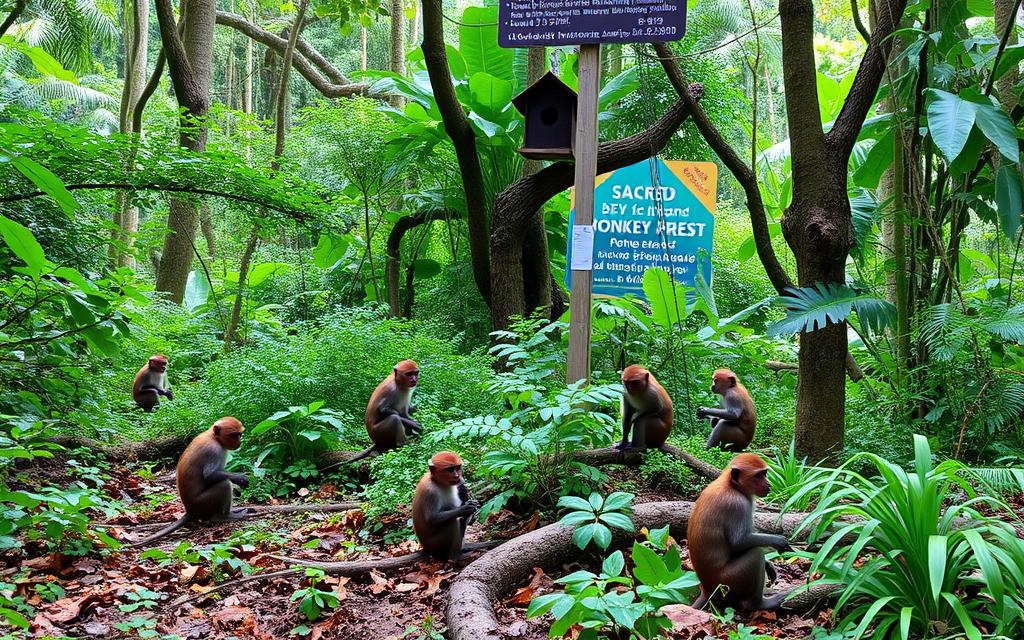
This method helps the ecosystem and boosts the local economy. Tourism grows in a way that helps both visitors and nature.
Ultimately, the Sacred Monkey Forest shows a big effort to balance human actions and nature. They aim for a future where nature and culture can both flourish.
Research and Monitoring in the Sanctuary
The Sacred Monkey Forest Sanctuary is deeply involved in research initiatives. These efforts aim to understand the macaques better. With partners like Udayana University, they study primate behavior and their living spaces. This helps them learn about the monkeys’ social lives.
Collations with Academic Institutions
Working with schools is key to wildlife research. It helps make better plans for protecting and saving animals. For example, over 1,000 Balinese monkeys are watched and studied. This info helps make the sanctuary better for them.
Such partnerships boost science and teach people about saving wildlife5.
Importance of Ongoing Research on Monkey Behavior
Studying monkey behavior is crucial for protecting wildlife and keeping nature healthy. By watching them often, we learn about their lives and health needs. This helps take better care of them.
The research also helps teach people about saving animals15. It can lead to ways to lessen the bad effects of tourism. This keeps the animals’ natural ways of life safe16.
Reforestation Programs and Habitat Preservation
Reforestation is key in the Sacred Monkey Forest’s conservation efforts. It involves planting native trees to fix damaged land and boost nature’s strength. This helps the long-tailed monkeys and other animals have great places to live.
Fixing habitats is crucial for wildlife and keeps the area’s variety of life. Each project tackles different forest problems, like soil loss and harmful plants. Working with local people is important, as they know the land well and help make conservation work.
These actions do a lot: they make ecosystems healthier, give homes to many species, and get people involved. Mixing old ways with new conservation ideas is key to keeping the forest right. You’ll see how planting trees helps the local wildlife and environment, showing the value of caring for nature.
“A shift towards sustainable practices can lead to a more vibrant ecosystem where wildlife and communities thrive together.”
Your support for planting trees in the Sacred Monkey Forest connects you with nature. It also protects the complex life systems in this special place. This ongoing effort is vital for keeping the variety of wildlife here for the future, showing why we must keep working on conservation17.
Ecotourism Initiatives in the Monkey Forest
Ecotourism and responsible tourism work together in the Sacred Monkey Forest. They help both wildlife and local communities. These efforts make sure that tourism is good for the environment and helps local people.
You’ll see how tourism helps local people get better. It connects tourism with local wealth.
Benefits of Responsible Wildlife Tourism
Responsible wildlife tourism is big for Bali’s economy. It makes up 45% of Indonesia’s tourism income18. This money helps protect the monkeys and their homes.
Many people visit each year. This money goes to education and protecting wildlife19.
Impact on Local Community Development
Tourism helps protect wildlife and helps local communities. In Bali, some tourism profits go to big companies19. But, local ecotourism makes things better for everyone.
The Sangeh Monkey Forest shows how this works. It helps monkeys and gives more money to locals19. This way, everyone works together and follows responsible tourism.
Challenges in Wildlife Protection
Wildlife protection in the Sacred Monkey Forest faces big challenges. A recent rabies outbreak affects monkeys and nearby communities. We need a deep understanding and a united effort to tackle these issues.
Addressing the Rabies Outbreak
The rabies outbreak is a big problem for conservation. Vaccines and sterilization are being used to control it. Working with health experts is key to keep monkeys and people safe.
Good strategies come from ongoing research and monitoring. Teaching the community about the risks helps support conservation efforts. This way, we can all work together to protect the monkeys and their home20.
Our aim is to keep the monkeys and their environment safe. We want to live in harmony with them, even with the challenges we face20.
Conclusion
The Sacred Monkey Forest is a key example of how to protect wildlife. It shows the importance of working with the community and taking care of the environment. This place is about 27 acres big and is home to over 700 monkeys and 186 types of trees21.
Visitors to the Sacred Monkey Forest help support a future where wildlife is safe. They do this by being responsible tourists. This means they help with things like fixing up the habitat, stopping diseases, and teaching people why nature is important22.
The Sacred Monkey Forest connects us to nature in a special way. It shows our commitment to protecting animals and their homes. With our support and awareness, Bali’s wildlife can thrive. This can inspire others around the world to do the same23.
FAQ
What is the Sacred Monkey Forest Sanctuary?
The Sacred Monkey Forest Sanctuary is a 12.5-hectare refuge in Ubud, Bali. It protects over 1,000 Balinese long-tailed monkeys. It also supports environmental sustainability and responsible tourism.
How does the Monkey Forest contribute to wildlife protection?
The sanctuary works on protecting wildlife through many efforts. It does conservation, community programs, reforestation, and education. These efforts teach the importance of saving endangered species.
Are the Balinese long-tailed monkeys endangered?
Balinese long-tailed monkeys are not endangered yet. But, their home is under threat. Conservation work aims to keep their environment safe and support biodiversity.
What is the significance of Tri Hita Karana in managing the sanctuary?
Tri Hita Karana teaches about living in harmony with nature and the divine. It guides the sanctuary to keep the environment balanced and protect cultural heritage.
How can visitors contribute to conservation efforts while visiting?
Visitors can help by being responsible tourists. They should respect the animals, follow the sanctuary’s rules, and join educational programs. These programs teach about taking care of the environment.
What are some challenges faced by the Sanctuary?
The sanctuary deals with rabies outbreaks, protecting wildlife, and making sure tourism doesn’t harm the monkeys or their home.
What role does community-based conservation play in the sanctuary?
Community-based conservation lets local people help protect wildlife. It teaches them about nature and makes sure the sanctuary works with the community’s needs for sustainable growth.
What kind of research is conducted in the Monkey Forest?
Researchers study primate behavior, ecology, and social life. They work with schools. This research helps make better conservation plans and understand what the monkeys need.
What impact does ecotourism have on the local community?
Ecotourism brings money for conservation and helps the community grow. It creates jobs and encourages visitors to live sustainably.
How is the forest being preserved and restored?
The sanctuary does reforestation, manages waste, and supports eco-friendly tourism. These efforts keep habitats safe and maintain biodiversity.
Source Links
- https://thebalisun.com/efforts-to-protect-tourists-at-balis-famous-monkey-forests-are-intensifying/
- https://villaamrita.com/monkey-forest-ubud-in-bali/
- https://baligram.me/blog/ubud-monkey-forest-sanctuary-a-sacred-place-where-monkeys-rule
- https://www.aljazeera.com/news/2021/9/22/is-it-time-to-rethink-balis-monkey-forests
- https://foreverbreak.com/travel/indonesia/bali/ubud/sacred-monkey-forest-sanctuary/
- https://www.pelago.com/en/articles/sacred-monkey-forest-sanctuary/
- https://medium.com/digital-global-traveler/the-entrancing-sacred-monkey-forest-sanctuary-of-bali-b7e695aca76d
- https://www.ramblynjazz.com/post/monkey-business-a-visit-to-ubud-s-famous-sanctuary
- https://monkeyforestubud.com/about-us/
- https://www.chrie.org/assets/docs/JHTC-case-notes/JHTC-vol-7/JHTC_Vol7Issue3-Bragg_case.pdf
- https://medium.com/@daniela.puglisi/ubud-balis-cultural-heart-monkey-forest-tegalalang-rice-terraces-d29dfb6cb38d
- https://monkeyforestubud.com/visit/
- https://www.ncbi.nlm.nih.gov/pmc/articles/PMC10777948/
- https://journalppw.com/index.php/jppw/article/download/3234/2105/3688
- https://monkeyforestubud.com/guidelines-faq/
- https://www.wildlifetourism.org.au/wp-content/uploads/2018/01/Negative_Effects_of_Wildlife_Tourism_on_Wildlife.pdf
- https://www.theconstantrevolution.com/the-alternative-kopel-eco-tourism-to-fund-forest-conservation/
- https://www.mdpi.com/2073-445X/9/6/186
- https://growfish.co/sustainable-marketing-in-bali-transforming-the-tourism-industry/
- https://www.cambridge.org/core/journals/oryx/article/complexities-of-local-cultural-protection-in-conservation-the-case-of-an-endangered-african-primate-and-forest-groves-protected-by-social-taboos/88CD0EF04A65E6A226603F44D978A52D
- https://woodsbali.com/blog/primates-nature-and-culture-ubud-monkey-forest/
- https://travel.earth/ubud-monkey-forest-sanctuary-bali/
- https://www.worldanimalprotection.us/siteassets/reports-programmatic/paradise-lost-report.pdf